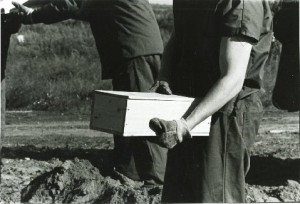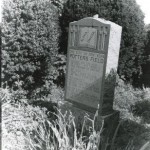
An unknown child being “buried” in the AIDS area.
Over 1,000,000 human beings are buried without dignity on Hart Island.
Yes, 1,000,000.
That includes stillborn infants, children who have died of AIDS, veterans, the indigent, the homeless, and unidentified people who died at hospitals and nursing homes. Also, individuals who died with no attempt made to identify them.
Their bodies rot in dilapidated graves. Not identified, not cared about, unknown to their families and to their loved ones. They are decaying without dignity. They are decaying in soil of the nation that many had fought to defend, many who had done good things during their lives, many who did not have the opportunity to make it to adulthood.
That is Hart Island, the easternmost entrance way to the Bronx and to New York City.
Unlike Ellis Island, this island did not welcome those who entered its boundaries. Entry to Hart Island is almost impossible unless you are a corpse. Bodies are brought over from Rikers Island by New York City Correction officers to be buried in New York’s Potter’s field.
Fetuses of infants are brought over from hospitals without their parents knowing where they were being taken. Quite often the mothers sign papers while sedated and have no idea what they are signing. The babies or fetuses are all buried in one particular part of Hart Island. There are two or three burial days a week here. The coffins are buried three-deep in trenches. The burial details are written up by Rikers Island inmates. Although relatives are able to find out which mass grave their child has been thrown into, they are unable to visit under Department of Correction rules. They are unable to visit, grieve their loss, or seek closure. The posts signify which hospital the infant comes from but nothing else. The human being thrown into the mass grave is rotting away without so much of a thought by officials who belong to the Department of Correction.
There are many stories of families trying to locate their loved ones in which the Department of Correction and the City do not help to assist. One sad case is the case of Penda Aiken and her sisters. For years they tried to locate their brother Jed. While they were able to find out that in the 1970s he was on the Bowery, they hired an investigative council, Charles Eric-Gordon. Eventually the detective’s investigation turned up a death certificate that showed Jed had died in a New York nursing home and been buried on Hart Island, without his family being notified.
Gordon said: “It’s just a shame that no effort was made to try to locate this poor fellow.” For Jed’s family, the discovery brought both certainty and sadness. They’re upset that so little effort was made to inform them and that Jed was buried without formalities in a mass grave they cannot visit. Penda Aiken said: “It was not a person, at that point. It was just that this is a process to get people buried that are not claimed and there is no effort to really reach out to find the families, because, financially, who knows, you know, the expense that it would take to make that kind of an effort is just not there.”
The work of Melinda Hunt and the Hart Island Project has reported this and many other cases of heartless decisions to just bury individuals without a sense of their being, as humans with a family and loved ones. This has to stop.
Over the years Hart Island has served as a quarantine for United States Navy Sailors with Yellow Fever, a tuberculerium, a reformatory for boys, an asylum for women with mental problems, a drug rehabilitation school, and even as a missile site. In addition, Hart Island was a prisoner-of-war camp for four months in 1865. At that time 3,413 captured Confederate soldiers were housed on the island. Approximately 235 died in the camp, and their remains, along with those of Union soldiers were buried there. Their bodies were moved to Cypress Hills Cemetery in Brooklyn in 1941.
There is an old chapel, deteriorating buildings, uncared for fields, a forgotten and abandoned baseball field with bleacher seats from Ebbets Field, and open burial pits.
We may be finally making progress in the endeavor to give an overdue respect to those buried on Hart Island and those who will be buried in the future. Council Members Jimmy Vacca and Mark Levine have introduced two bills which would finally bestow respect on those buried on Hart Island. One piece of legislation would transfer jurisdiction of Hart Island from the Department of Correction to the Department of Parks and recreation. The other legislation would provide for transportation to Hart Island. The entire New York City Council Bronx delegation has signed on.
This issue will come before Community Board #10 this Thursday, January 15th. Hopefully the legislation will move forward quickly. Presently, the Department of Correction is planning the destruction of many of the historical buildings on Hart Island. This has to be stopped. Most importantly the defaming of the dead must cease.
The work being done by John Doyle is exemplary as well as the work of Melinda Hunt, of the Hart island Project, demands accolades.
- View of City Island and Hart Island
- Many burial pits remain open to the ravages of the weather
- These were beds used by those residents in the asylum for women, those with tuberculosis
- The chapel is now in disrepair. It was used when the asylum for women was on the island and for those in the Phoenix House progra,
- Inside the chapel. the stained glass windows are gone
- This building housed some of those from the asylum
- Entrance to the mess hall
- This building was used as an asylum and as a drug rehabilitation center
- These rotting files in the Pavillion Building. Records of the deceased: more disrespect.
- These coffins were awaiting burial. The names of the children are visible, Coffins were not buried until there were over 130 to be buried. Total disresect.
- Awaiting burial
- Area on Hart Island where infants and childre who died from AIDS are buried without identity or respect

























Follow Us